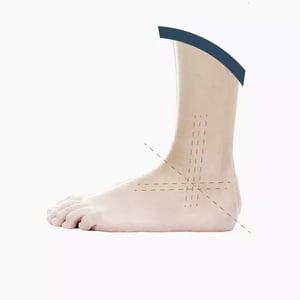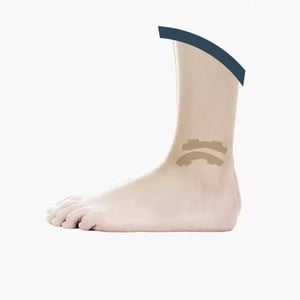From Prosthesis to Prosthesis
Ankle arthroplasty is the solution for treating ankle arthritis.
Introduction
Ankle arthroplasty is currently considered the preferred treatment for ankle arthritis.
It is not a novelty nor a surprise, but it is certainly a recent advancement.
Today’s reliability is the result of an evolution in prosthetic designs, along with extensive research and a deeper understanding of ankle biomechanics.
The initial ankle prostheses of the 1970s were essentially modified hip replacements—too simplistic in design to achieve stable, long-term outcomes.
These early attempts can be attributed to the scientific enthusiasm of the time. Hip arthroplasty, for instance, has been a success since its inception.
In fact, the World Health Organization (WHO) has defined hip replacement as “the most successful operation of the last century.”
The early evolution of ankle prostheses led to large and restrictive designs, intended to address the risk of dislocation.
The key to modern success lies in the complete reworking of these principles over the past decade: successful ankle prosthetic designs must minimize bone resection and replicate the original anatomy of the ankle as efficiently as possible.
This is why we have focused on understanding the unique characteristics of the ankle—because the ankle doesn’t age!
It’s a theme I often address in my practice: despite the demands of standing and bearing weight throughout life, the ankle’s remarkable anatomy allows it to protect itself from the effects of aging.
Arthritis is not necessarily a condition linked to old age or excess weight. It tends to develop due to other factors that are independent of a patient's age, such as:
- Deformities (e.g., severe flatfoot or cavus foot)
- Previous trauma (e.g., repeated fractures or ankle sprains)
- Systemic inflammatory diseases (such as rheumatoid arthritis or lupus)
The ankle maintains its efficiency over time because of its congruency—each surface fits perfectly with the corresponding one. This congruence must be recreated in a successful prosthetic design, with features like an anatomical talus, a truncated cone shape (where the medial radius is shorter than the lateral ray), and a preserved anterior tibial cortex.
When considering a prosthesis revision, it’s crucial to identify the type of prosthesis that needs to be revised.
First- and second-generation prostheses, when revised, require the surgeon to address the bone defects left by the removal of these bulky implants.
In contrast, revising a modern prosthetic implant that has preserved bone stock is a different process. Revision strategies are more straightforward in these cases, allowing for the replacement of the prosthesis with a new one while preserving the ankle's range of motion.
The Role of the Learning Curve in Surgery for the Implant’s Survival

Prosthetic surgery, regardless of the anatomical area, benefits from large volumes of procedures.
It is universally accepted and supported by scientific evidence that reference centers, and specifically high-volume surgical teams within these centers, play a central role in prosthetic surgery. They are key not only in managing the initial prosthetic implant and its revision but also in training specialized surgeons.
Numerous scientific studies have been dedicated to the concept of the "learning curve"—the process by which a surgeon becomes fully proficient and reliable in performing a specific surgical procedure, particularly in the context of prosthetic implants.
In the field of ankle prosthesis and learning curves, my team, one of the pioneers in this area, has conducted and published several key studies: “Identifying the Learning Curve for Total Ankle Replacement Using a Mobile Bearing Prosthesis” (published in the European Journal of Chirurgia della Caviglia e del Piede: Foot and Ankle Surgery) and “Pearls and Pitfalls for a Surgeon New to Ankle Replacements” (published in Foot and Ankle Clinics).
Through these studies, we were able to identify, for the first time, a specific cut-off point at which a surgeon specializing in ankle prosthetic surgery can be considered to have completed their learning curve.
According to our published data, a surgeon can be considered an expert in the field after performing 30 cases.
However, the total number of cases is not the only factor; the number of cases performed per year is also crucial, as it defines the surgeon’s ongoing practice in prosthetic surgery.
In recent years, reference centers both in Italy and globally have been focusing on the establishment of Prosthetic Registries. These registries track key data, including:
- The number of surgeries performed
- The types of prostheses implanted
- The revision rates
However, the data can often prove to be sterile and difficult to interpret. This is a topic we recently addressed in one of our studies, published in the European Ankle and Foot Surgery journal.
To meet these modern needs, the Institute where I worked for 10 years, IRCCS Galeazzi, pioneered the creation of a prosthetic surgery registry. In this registry, alongside traditional data, we also collect objective data and assessment scales administered by the surgeon, as well as patient-reported outcomes (PROMS) related to satisfaction and the perception of the surgery.
The novelty and significance of this initiative lie in its ultimate benefit to both science and patients. It is driven by the goal of studying and understanding ankle arthritis and the role of ankle prostheses.
From the outset, it has been a source of pride for me to serve on the Board of this prosthetic registry. I believe it is an ethically necessary commitment to our patients—both past, present, and future.
Revision Strategies
A prosthesis may require revision due to complications or simply from long-term wear and tear.
Contrary to previous beliefs, revising a prosthesis does not always mean it must be removed and replaced with arthrodesis (ankle fusion).
It is possible to revise a prosthesis with another, ideally aiming to maintain joint movement and preserve the most physiological walking pattern.
The revision of an ankle prosthesis involves different strategies. The decision-making process must consider the cause of failure and the amount of residual bone, especially at the talus level (residual bone stock).
Causes of Failure

X-rays of a new prosthesis (from right to left; lateral, frontal, and posterior views)

The failure of an ankle replacement surgery can happen for several reasons, typically falling into three main categories:
- Prosthetic Implant Failure
- Implant Mobilization and Peri-prosthetic Fractures
- Infection
Infection, in particular, has its own distinct history and requires different protocols compared to the other two failure causes. This is a topic we have thoroughly explored in our studies, aiming to provide patients with reliable alternatives and better management strategies.
È, quindi, un argomento su cui abbiamo pubblicato, proponendo la nostra strategia terapeutica in un nostro articolo sulla rivista europea di chirurgia della caviglia e del piede: “Infections in primary total ankle replacement: Anterior approach versus lateral transfibular approach”.
The treatment primarily focuses on addressing and healing the infection.
In the case of an acute infection (occurring within the first 6 months after surgery), the initial surgical procedure is typically followed by a specific combined antibiotic therapy, which usually lasts from 2 to 3 months.
If the infection is chronic (lasting over 6 months), or if the previous treatment has not been effective, the standard procedure involves the removal of the prosthesis, which is then replaced with a spacer implant made of antibiotic cement.
It is usually possible for the patient to bear weight on the spacer within a month after surgery. If the patient is satisfied, the spacer can remain in place for the rest of their life. However, if the patient is considered to have recovered from the infection but continues to experience pain, a revision procedure may be recommended.
Once clinical recovery is achieved and if there is sufficient bone-stock (residual bone), a new prosthesis can be implanted.
In cases where the failure is due to either prosthetic implant failure or implant mobilization/peri-prosthetic fractures, two distinct revision strategies can be identified, depending on the amount of residual bone available in the talus.
If the amount of healthy bone at the talus level is sufficient, it is advisable to replace the failed prosthesis with another "first implant" prosthesis, rather than using a revision implant.
The advantage of this approach is that it helps conserve bone, reduces the invasiveness of the procedure, and preserves the option for a second revision if necessary in the future.
In these cases, the lateral approach is particularly beneficial because it provides the surgeon with a broader and more direct view of the joint, avoiding previous scars and deep adhesions. This approach allows for the removal of the initial implant and a revision that prioritizes biological economy, meaning that as much bone as possible is preserved.
If the residual bone-stock is insufficient, modern revision systems offer excellent possibilities. These include replacing the talus entirely with talus prostheses or custom-made prostheses, offering viable solutions even when there is limited bone remaining.
These are advancements driven by technology across various fields. Three-dimensional printers and vision systems now enable the creation of instruments specifically tailored to address the pathology or skeletal defect of each individual patient. This level of customization helps optimize treatment outcomes, offering more precise and personalized solutions for complex medical conditions.
My Team and Research: What we have Introduced
My team has always focused on two essential areas in the field of revision surgery: the study and management of infections, and the collection and interpretation of data related to learning curves in prosthetic surgery.
Our scientific contributions have led to the identification of key cut-offs—clear, measurable milestones that define a surgeon's development and expertise in ankle prosthetics.
We believe that these insights will serve as motivation for reference centers and teams dedicated to treating ankle arthritis, helping to further optimize and refine treatment protocols.
Personally, I was involved in the establishment of the Ankle Prosthetic Surgery Registry at IRCCS Galeazzi, where I worked before becoming the Chief of Foot and Ankle Orthopaedics at Humanitas San Pio X. I continue to contribute to its development with great enthusiasm as a member of the Board.
The Ankle Prosthetic Surgery Registry is a national initiative designed to collect clinical data from surgeons, now integrated with the patient’s direct feedback. This combination offers a more comprehensive view of treatment outcomes and patient satisfaction.
We believe that the development of this registry, with its unique characteristics, will be crucial in shaping future evaluations of the success of initial prosthetic implants and the outcomes of revision surgeries.
Our ongoing scientific work is focused in this direction. We've already published a study on the current role of prosthetic registries, where we explore how to enhance them to ensure they truly contribute to the advancement of prosthetic surgery.
Scientific publications:
- Identifying the learning curve for total ankle replacement using a mobile bearing prosthesis
- Pearls and Pitfalls for a Surgeon New to Ankle Replacements
- Total ankle arthroplasty and national registers: What is the impact on scientific production?
- Infections in primary total ankle replacement: Anterior approach versus lateral transfibular approach

.webp?width=300&name=protesi-caviglia-mobile-bearing-min.jpg%20(1).webp)
